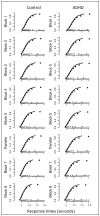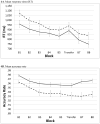Evaluating the consequences of impaired monitoring of learned behavior in attention-deficit/hyperactivity disorder using a Bayesian hierarchical model of choice response time
- PMID: 26866345
- PMCID: PMC4840080
- DOI: 10.1037/neu0000257
Evaluating the consequences of impaired monitoring of learned behavior in attention-deficit/hyperactivity disorder using a Bayesian hierarchical model of choice response time
Abstract
Objective: Performance monitoring deficits have been proposed as a cognitive marker involved in the development of attention-deficit/hyperactivity disorder (ADHD), but it is unclear whether these deficits cause impairment when established action sequences conflict with environmental demands. The current study applies a novel data-analytic technique to a well-established sequence learning paradigm to investigate reactions to disruption of learned behavior in ADHD.
Method: Children (ages 8-12) with and without ADHD completed a serial reaction time task in which they implicitly learned an 8-item sequence of keypresses over 5 training blocks. The training sequence was replaced with a novel sequence in a transfer block, and returned in 2 subsequent recovery blocks. Response time (RT) data were fit by a Bayesian hierarchical version of the linear ballistic accumulator model, which permitted the dissociation of learning processes from performance monitoring effects on RT.
Results: Sequence-specific learning on the task was reflected in the systematic reduction of the amount of evidence required to initiate a response, and was unimpaired in ADHD. When the novel sequence onset, typically developing children displayed a shift in their attentional state while children with ADHD did not, leading to worse subsequent performance compared to controls.
Conclusions: Children with ADHD are not impaired in learning novel action sequences, but display difficulty monitoring their implementation and engaging top-down control when they become inadequate. These results support theories of ADHD that highlight the interactions between monitoring processes and changing cognitive demands as the cause of self-regulation and information-processing problems in the disorder. (PsycINFO Database Record
(c) 2016 APA, all rights reserved).
Conflict of interest statement
The authors have no conflicts of interest to report.
Figures





Similar articles
-
Evidence of motor-control difficulties in children with attention deficit hyperactivity disorder, explored through a hierarchical motor-systems perspective.J Clin Exp Neuropsychol. 2016;38(2):183-96. doi: 10.1080/13803395.2015.1094028. Epub 2015 Nov 23. J Clin Exp Neuropsychol. 2016. PMID: 26595141
-
Task-related electroencephalographic deviances in adults with attention deficit hyperactivity disorder.Neuropsychology. 2015 May;29(3):433-44. doi: 10.1037/neu0000148. Epub 2014 Oct 20. Neuropsychology. 2015. PMID: 25329936
-
Two forms of implicit learning in childhood ADHD.Dev Neuropsychol. 2010;35(5):494-505. doi: 10.1080/87565641.2010.494750. Dev Neuropsychol. 2010. PMID: 20721771 Free PMC article.
-
A meta-analytic study of event rate effects on Go/No-Go performance in attention-deficit/hyperactivity disorder.Biol Psychiatry. 2012 Dec 15;72(12):990-6. doi: 10.1016/j.biopsych.2012.08.023. Epub 2012 Oct 11. Biol Psychiatry. 2012. PMID: 23062355 Review.
-
Procedural Sequence Learning in Attention Deficit Hyperactivity Disorder: A Meta-Analysis.Front Psychol. 2020 Oct 28;11:560064. doi: 10.3389/fpsyg.2020.560064. eCollection 2020. Front Psychol. 2020. PMID: 33192824 Free PMC article.
Cited by
-
A review of visual sustained attention: neural mechanisms and computational models.PeerJ. 2023 Jun 13;11:e15351. doi: 10.7717/peerj.15351. eCollection 2023. PeerJ. 2023. PMID: 37334118 Free PMC article. Review.
-
Preferential Choice to Exert Cognitive Effort in Children with ADHD: a Diffusion Modelling Account.Res Child Adolesc Psychopathol. 2023 Oct;51(10):1497-1509. doi: 10.1007/s10802-023-01080-x. Epub 2023 May 26. Res Child Adolesc Psychopathol. 2023. PMID: 37233896 Free PMC article.
-
Model-based assessment and neural correlates of spatial memory deficits in mild cognitive impairment.Neuropsychologia. 2020 Jan;136:107251. doi: 10.1016/j.neuropsychologia.2019.107251. Epub 2019 Nov 5. Neuropsychologia. 2020. PMID: 31698011 Free PMC article.
-
Using the Diffusion Model to Explain Cognitive Deficits in Attention Deficit Hyperactivity Disorder.J Abnorm Child Psychol. 2017 Jan;45(1):57-68. doi: 10.1007/s10802-016-0151-y. J Abnorm Child Psychol. 2017. PMID: 27030470 Free PMC article.
-
A diffusion model analysis of sustained attention in children with attention deficit hyperactivity disorder.Neuropsychology. 2020 Sep;34(6):641-653. doi: 10.1037/neu0000636. Epub 2020 Apr 23. Neuropsychology. 2020. PMID: 32324003 Free PMC article.
References
-
- APA. Diagnostic and statistical manual of mental disorders. 4. Washington, D.C: 1994.
-
- Albrecht B, Brandeis D, Uebel H, Heinrich H, Mueller UC, Hasselhorn M, … Banaschewski T. Action monitoring in boys with attention-deficit/hyperactivity disorder, their nonaffected siblings, and normal control subjects: Evidence for an endophenotype. Biological Psychiatry. 2008;64(7):615–625. - PMC - PubMed
-
- Aston-Jones G, Cohen JD. An integrative theory of locus coeruleus-norepinephrine function: adaptive gain and optimal performance. Annual Reviews of Neuroscence. 2005;28:403–450. - PubMed
-
- Balogh L, Czobor P. Post-Error Slowing in Patients With ADHD A Meta-Analysis. Journal of Attention Disorders. 2014 1087054714528043. - PubMed
-
- Barkley RA. Behavioral inhibition, sustained attention, and executive functions: constructing a unifying theory of ADHD. Psychological Bulletin. 1997;121(1):65. - PubMed
MeSH terms
Grants and funding
LinkOut - more resources
Full Text Sources
Other Literature Sources
Medical

